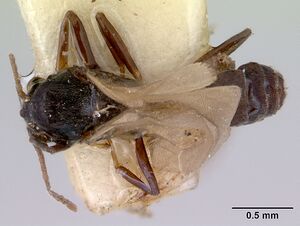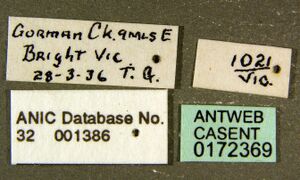Doleromyrma darwiniana
| Doleromyrma darwiniana | |
|---|---|

| |
| Scientific classification | |
| Kingdom: | Animalia |
| Phylum: | Arthropoda |
| Class: | Insecta |
| Order: | Hymenoptera |
| Family: | Formicidae |
| Subfamily: | Dolichoderinae |
| Genus: | Doleromyrma |
| Species: | D. darwiniana |
| Binomial name | |
| Doleromyrma darwiniana (Forel, 1907) | |
| Subspecies | |
| |
Photo Gallery
| At a Glance | • Limited invasive |
Identification
Distribution
Latitudinal Distribution Pattern
Latitudinal Range: -24.96535° to -35.25833511°.
| North Temperate |
North Subtropical |
Tropical | South Subtropical |
South Temperate |
- Source: AntMaps
Distribution based on Regional Taxon Lists
Australasian Region: Australia (type locality), New Zealand.
Distribution based on AntMaps
Distribution based on AntWeb specimens
Check data from AntWeb
Countries Occupied
| Number of countries occupied by this species based on AntWiki Regional Taxon Lists. In general, fewer countries occupied indicates a narrower range, while more countries indicates a more widespread species. |

|
Estimated Abundance
| Relative abundance based on number of AntMaps records per species (this species within the purple bar). Fewer records (to the left) indicates a less abundant/encountered species while more records (to the right) indicates more abundant/encountered species. |

|
Biology
Castes
Queen
Images from AntWeb
 
| |
| Male (alate). Specimen code casent0172371. Photographer April Nobile, uploaded by California Academy of Sciences. | Owned by ANIC, Canberra, Australia. |
Male
Images from AntWeb
     
| |
| Male (alate). Specimen code casent0172369. Photographer April Nobile, uploaded by California Academy of Sciences. | Owned by ANIC, Canberra, Australia. |
Nomenclature
The following information is derived from Barry Bolton's Online Catalogue of the Ants of the World.
- darwiniana. Tapinoma (Doleromyrma) darwinianum Forel, 1907a: 28 (w.m.) AUSTRALIA. Imai, Crozier & Taylor, 1977: 345 (k.). Combination in Iridomyrmex: Emery, 1913a: 24; in Doleromyrma: Shattuck, 1992a: 14. Current subspecies: nominal plus fida, leae.
Type Material
- Tapinoma (Doleromyrma) darwinianum Forel, 1907: Syntype, 1 worker, Mt. Victoria, Blue Mountains, New South Wales, Australia, <collector unknown>, ANIC32-001666, Australian National Insect Collection.
- Tapinoma (Doleromyrma) darwinianum Forel, 1907: Syntype, 2 workers, Mt. Victoria, Blue Mountains, New South Wales, Australia, Museum of Comparative Zoology.
- Tapinoma (Doleromyrma) darwinianum Forel, 1907: Syntype, 3 workers, 1 male, Mt. Victoria, Blue Mountains, New South Wales, Australia, Musee d'Histoire Naturelle Genève.
Description
References
- Emery, C. 1913a [1912]. Hymenoptera. Fam. Formicidae. Subfam. Dolichoderinae. Genera Insectorum 137: 1-50 (page 24, Combination in Iridomyrmex)
- Forel, A. 1907d. Formicides du Musée National Hongrois. Ann. Hist.-Nat. Mus. Natl. Hung. 5: 1-42 (page 28, worker, male described)
- Heterick, B.E. 2021. A guide to the ants of Western Australia. Part I: Systematics. Records of the Western Australian Museum, Supplement 86, 1-245 (doi:10.18195/issn.0313-122x.86.2021.001-245).
- Heterick, B.E. 2022. A guide to the ants of Western Australia. Part II: Distribution and biology. Records of the Western Australian Museum, supplement 86: 247-510 (doi:10.18195/issn.0313-122x.86.2022.247-510).
- Imai, H. T.; Crozier, R. H.; Taylor, R. W. 1977. Karyotype evolution in Australian ants. Chromosoma (Berl.) 59: 341-393 (page 345, karyotype described)
- Shattuck, S. O. 1992a. Review of the dolichoderine ant genus Iridomyrmex Mayr with descriptions of three new genera (Hymenoptera: Formicidae). J. Aust. Entomol. Soc. 31: 13-18 (page 14, Combination in Doleromyrma)
References based on Global Ant Biodiversity Informatics
- Briese D. T., and B. J. Macauley. 1977. Physical structure of an ant community in semi-Arid Australia
- Clark J. 1934. Ants from the Otway Ranges. Memoirs of the National Museum of Victoria 8: 48-73.
- Majer J. D., and O. G. Nichols. 1998. Long-term recolonization patterns of ants in Western Australian rehabilitated bauxite mines with reference to their use as indicators of restoration success. Journal of Applied Ecology 35: 161-182.
- Majer, J.D. and O.G. Nichols. 1998. Long-Term Recolonization Patterns of Ants in Western Australian Rehabilitated Bauxite Mines with Reference to Their Use as Indicators of Restoration Success. Journal of Applied Ecology 35(1):161-182
- Taylor R. W. 1987. A checklist of the ants of Australia, New Caledonia and New Zealand (Hymenoptera: Formicidae). CSIRO (Commonwealth Scientific and Industrial Research Organization) Division of Entomology Report 41: 1-92.
- York. 2000. Long-term effects of frequent low-intensity burning on ant communities in coastal blackbutt forests of southeastern Australia. Austral Ecology 25: 83-98.


